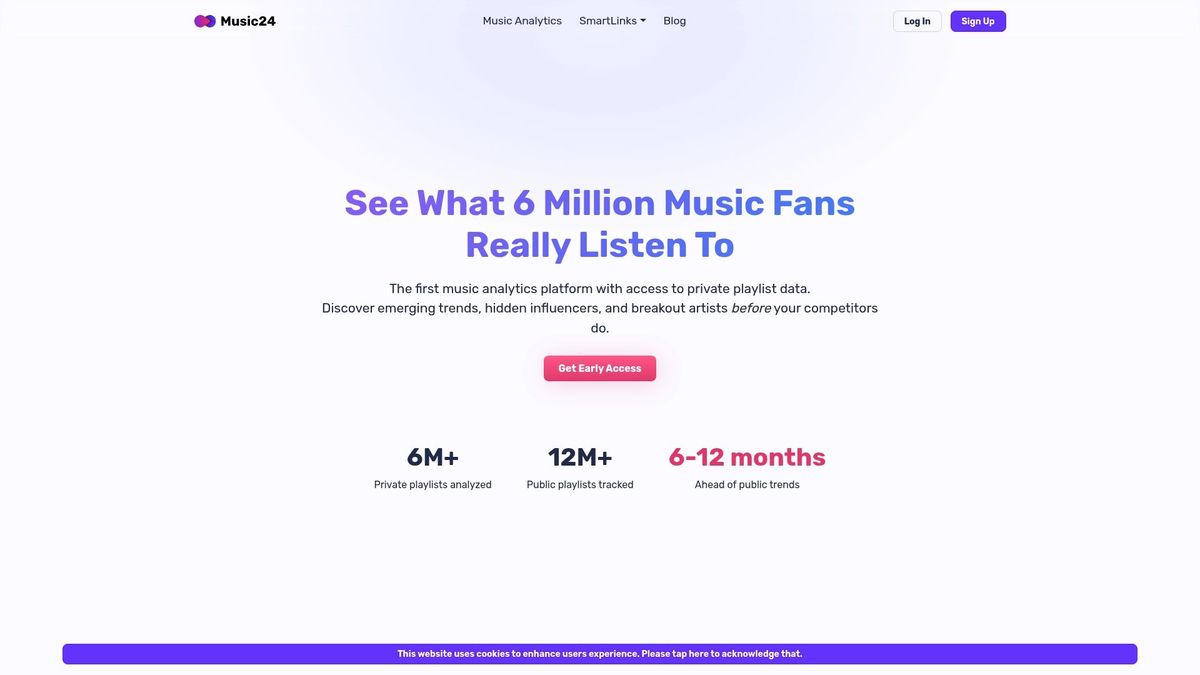Music professionals used to rely on gut feeling and radio play to spot the next hit. Now, machine learning algorithms can predict music trends and listener behavior with more accuracy than human experts. The wild part is this technology is not just for the big streaming platforms anymore, and even indie labels and artist managers are using deep data analysis to find new talent before anyone else knows their name.
Table of Contents
- What Is Music Data Interpretation?
- Why Music Data Interpretation Matters in the Industry
- How Music Data Interpretation Works
- Key Concepts in Music Data Analysis
- Real-World Applications of Music Data Interpretation
Quick Summary
| Takeaway | Explanation |
|---|---|
| Music data drives industry decisions | Understanding data insights helps professionals make informed choices about marketing, artist development, and audience engagement. |
| Predictive analytics identifies trends | Analyzing listener behavior allows for forecasting emerging genres and optimizing marketing strategies effectively. |
| Data interpretation enhances talent discovery | Advanced analytics reveal rising artists and their potential, leading to better career management and recruitment. |
| Visualizations simplify complex data | Transforming data into intuitive graphs aids industry professionals in achieving actionable insights quickly. |
| Quantitative analysis complements creative intuition | Combining data with artistic sensibility leads to informed decisions about production and marketing in music. |
What is Music Data Interpretation?
Music data interpretation represents a sophisticated analytical approach that transforms raw musical information into meaningful insights, enabling professionals in the music industry to understand complex patterns, trends, and listener behaviors. At its core, this discipline combines advanced computational techniques with deep musical understanding to extract valuable knowledge from diverse data sources.
The Fundamental Components
Music data interpretation involves multiple critical elements that work together to generate comprehensive insights. These components include:
- Audio Content Analysis: Examining the intrinsic musical characteristics like rhythm, melody, harmony, and timbre
- User Behavior Tracking: Analyzing listener interactions, streaming patterns, and engagement metrics
- Metadata Processing: Extracting information from song descriptions, artist details, and genre classifications
By integrating these components, music professionals can gain unprecedented visibility into audience preferences and emerging musical trends.
Below is a table summarizing the fundamental components of music data interpretation and their main functions to clarify their roles for industry professionals.
| Component | Description |
|---|---|
| Audio Content Analysis | Examines intrinsic musical elements, such as rhythm, melody, harmony, and timbre |
| User Behavior Tracking | Analyzes listener interactions, streaming patterns, and engagement metrics |
| Metadata Processing | Extracts information from song descriptions, artist details, and genre classifications |
 According to IEEE Digital Signal Processing Research, computational techniques enable unprecedented depth in understanding musical structures and listener interactions.
According to IEEE Digital Signal Processing Research, computational techniques enable unprecedented depth in understanding musical structures and listener interactions.
Practical Applications in the Music Industry
The guide to music data interpretation goes beyond theoretical analysis. Record labels, artist managers, and music marketers leverage these insights to make strategic decisions. This might include identifying emerging artists, predicting genre shifts, understanding playlist dynamics, or developing targeted marketing strategies.
For instance, by analyzing private playlist data, music industry professionals can detect authentic music discovery patterns before they become visible through traditional public metrics. This predictive capability allows for early talent identification and strategic positioning in a rapidly evolving musical landscape.
Music data interpretation transforms complex datasets into actionable intelligence, bridging the gap between raw information and strategic musical insights. It represents a powerful tool for understanding the intricate dynamics of music consumption and creation in the digital age.
Why Music Data Interpretation Matters in the Industry
In the rapidly evolving digital music landscape, data interpretation has transformed from a supplementary strategy to a critical business imperative. Music professionals now recognize that comprehensive data analysis provides a competitive edge in understanding listener preferences, predicting market trends, and making strategic decisions.
Economic and Strategic Significance
Music data interpretation serves as a powerful economic tool that enables industry stakeholders to optimize resource allocation and minimize financial risks. By analyzing complex datasets, record labels, artist managers, and music marketers can:
- Predict Audience Trends: Forecast emerging musical genres and listener preferences
- Optimize Marketing Strategies: Target specific demographic segments with precision
- Talent Discovery: Identify promising artists before they gain mainstream recognition
According to OECD Research on Digital Literacy, data interpretation skills are increasingly crucial across industries, highlighting the broader significance of these analytical capabilities.
Transforming Creative Decision Making
Traditionally, music industry decisions were driven by intuition and personal networks. Today, data interpretation provides objective insights that complement creative expertise. Quantitative analysis now plays a pivotal role in understanding listener behavior, helping professionals make more informed choices about artist development, album production, and marketing campaigns.
For instance, private playlist data can reveal micro-trends and listener preferences that traditional public metrics might overlook. Learn more about our advanced playlist analytics to understand how granular data can transform music industry strategies.
By bridging the gap between artistic creativity and data-driven decision making, music data interpretation empowers professionals to navigate an increasingly complex and competitive musical ecosystem. It represents not just a technological advancement, but a fundamental shift in how the music industry understands and responds to audience dynamics.
How Music Data Interpretation Works
Music data interpretation operates through a sophisticated, multilayered process that transforms raw musical information into actionable insights. This complex methodology combines advanced computational techniques, statistical analysis, and domain-specific knowledge to extract meaningful patterns and trends from diverse musical datasets.
Data Collection and Preprocessing
The initial stage of music data interpretation involves comprehensive data gathering from multiple sources. These sources include:
- Streaming Platform Metrics: User engagement, play counts, skip rates
- Social Media Interactions: Artist mentions, listener comments, trend discussions
- Private Playlist Data: Listener curation patterns, genre blending behaviors
Preliminary data preprocessing is crucial, involving cleaning, standardizing, and organizing information to ensure accuracy and reliability. This step eliminates inconsistencies and prepares the dataset for advanced analytical techniques.
Advanced Analytical Techniques
Once preprocessed, the data undergoes rigorous computational analysis. According to NIH Research on Music Data Analysis, this involves sophisticated approaches like machine learning algorithms, time series analysis, and feature extraction. These techniques enable professionals to:
- Identify emerging musical trends
- Predict listener preferences
- Understand complex genre interactions
Machine learning models, in particular, can detect subtle patterns that human analysts might overlook, providing unprecedented insights into musical consumption behaviors.
Visualization and Strategic Insights
The final stage transforms complex analytical results into comprehensible visualizations and strategic recommendations. By converting raw data into intuitive graphs, charts, and predictive models, music industry professionals can make informed decisions about artist development, marketing strategies, and audience engagement.
Learn more about our advanced data visualization tools and discover how granular insights can revolutionize music industry strategies. Music data interpretation is not just about collecting information, but about translating complex datasets into meaningful, actionable intelligence that drives creative and business decisions in the modern music landscape.
Key Concepts in Music Data Analysis
Music data analysis represents a sophisticated intersection of technological innovation and musical expertise, requiring professionals to understand complex analytical frameworks that transform raw musical information into strategic insights. By mastering fundamental concepts, music industry professionals can unlock powerful predictive and interpretative capabilities.
Foundational Analytical Frameworks
The core of music data analysis involves several critical conceptual approaches that enable comprehensive understanding of musical ecosystems. These frameworks provide structured methodologies for extracting meaningful patterns and trends:
- Quantitative Analysis: Numerical measurement of musical attributes like tempo, genre distribution, and listener engagement
- Qualitative Assessment: Contextual interpretation of musical trends and cultural significance
- Predictive Modeling: Using historical data to forecast future musical developments
According to Berklee College of Music's Data Analytics Research, these analytical approaches help transform complex datasets into actionable strategic intelligence for music industry professionals.
Advanced Analytical Techniques
Modern music data analysis employs sophisticated techniques that go beyond traditional statistical methods. Machine learning algorithms and network analysis enable researchers to uncover intricate relationships within musical datasets. These techniques allow for nuanced exploration of:
- Genre hybridization patterns
- Listener behavior prediction
- Emerging artist discovery mechanisms
Mathematical models can now detect subtle connections that human analysts might overlook, providing unprecedented insights into musical consumption and creation dynamics.
Visualization and Interpretation Strategies
Transforming complex analytical results into comprehensible visual representations is crucial for effective music data analysis. Professionals use advanced data visualization techniques to translate intricate datasets into intuitive graphics that communicate complex insights quickly and effectively. Explore our privacy guidelines for data interpretation to understand the ethical considerations in music data analysis.
By integrating technological sophistication with deep musical understanding, music data analysis continues to revolutionize how the industry identifies trends, understands audience behaviors, and makes strategic decisions.
Real-World Applications of Music Data Interpretation
Music data interpretation transcends theoretical analysis, delivering tangible strategic advantages across multiple sectors of the music industry. By transforming complex datasets into actionable insights, professionals can make informed decisions that drive creativity, marketing, and business growth.
Artist Development and Talent Acquisition
Data interpretation provides unprecedented capabilities for identifying and nurturing musical talent. Record labels and artist management teams leverage advanced analytics to:
- Discover Emerging Artists: Detect rising performers through streaming patterns and listener engagement
- Predict Career Trajectories: Analyze historical data to forecast potential breakout success
- Optimize Artist Positioning: Understand genre crossover potential and audience demographics
Quantitative insights enable more strategic artist development, reducing traditional trial and error approaches in talent identification and career management.
Marketing and Audience Engagement
Music marketing has been revolutionized by data-driven strategies that go beyond traditional demographic targeting. By analyzing listener behaviors, professionals can:
- Create hyper-personalized promotional campaigns
- Identify optimal release strategies
- Map listener journey and consumption patterns
Explore our advanced music analytics features to understand how granular data transforms marketing approaches. Marketing teams now use predictive models to anticipate listener preferences with remarkable accuracy.
Revenue Optimization and Strategic Planning
Record labels, streaming platforms, and music publishers utilize data interpretation to make critical financial decisions. Advanced analytics help in:
- Negotiating artist contracts
- Identifying lucrative licensing opportunities
- Predicting revenue streams across different markets
By converting complex listener data into strategic intelligence, music industry professionals can develop more precise, data-informed business strategies that minimize risk and maximize potential revenue.
This table highlights real-world applications of music data interpretation by comparing the primary goals and benefits across key music industry functions.
| Application Area | Objectives | Key Benefits |
|---|---|---|
| Artist Development & Talent Acquisition | Discover emerging artists, predict career paths | Early identification of talent, optimized career planning |
| Marketing & Audience Engagement | Personalize campaigns, track listener behavior | Increased engagement, more effective targeting |
| Revenue Optimization & Strategic Planning | Forecast revenue, identify new opportunities | Minimized risk, precise business strategy |

Unlock the Power of Predictive Music Analytics for Early Talent Discovery
Are you tired of chasing trends that have already peaked? The article highlighted the struggle of making sense of vast, complex music data and how missing out on early signals can delay your competitive edge. If you want to interpret private playlist patterns, track genuine music discovery, and understand nuanced trends in real time, you need analytics that go much deeper than public charts or social feeds allow.

Experience how Music24 puts you ahead of the curve. With our platform’s proprietary access to private playlists, you can spot emerging artists and micro-trends before anyone else. Turn hard-to-read data into clear, actionable steps so you can discover talent, evolve your marketing, and make data-driven decisions that actually matter. Do not let insights pass you by while others race ahead. Visit Music24.com now and start turning raw data into your next big breakthrough.
Frequently Asked Questions
What is music data interpretation?
Music data interpretation is an analytical approach that transforms raw musical information into meaningful insights, helping music industry professionals understand patterns, trends, and listener behaviors.
How does music data interpretation benefit artists and record labels?
Music data interpretation aids in artist development, talent discovery, predicting audience trends, and optimizing marketing strategies based on listener behavior and preferences.
What are the key components of music data interpretation?
The main components include audio content analysis, user behavior tracking, and metadata processing, all of which contribute to generating comprehensive insights into music consumption.
What techniques are used in advanced music data analysis?
Advanced techniques include machine learning algorithms, time series analysis, and feature extraction, which help identify emerging musical trends and predict listener preferences.


